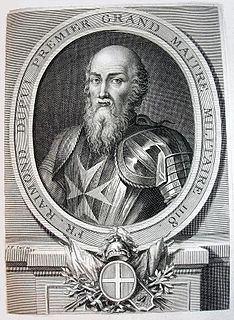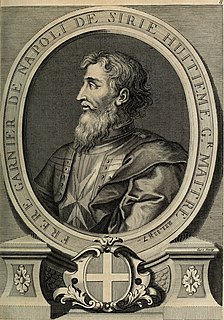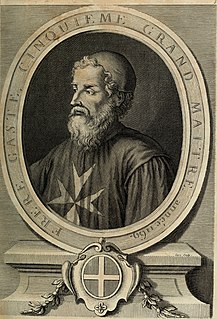
Raymond du Puy (1083–1160) was a knight from Dauphiné in France and the second Grand Master of the Knights Hospitaller, also known as the Order of St. John of Jerusalem, from around 1121 until 1160. Officially, he succeeded Blessed Gerard, the founder of the Order, as Grand Master. While traditionally cited as the direct successor upon Gerard's death in 1118 or 1120, his assumption of the magisterium was in 1121 or 1123 after one or two interim superiors, Pierre de Barcelona and Boyant Roger. Raymond divided the membership of the Order into clerical, military, and serving brothers and established the first significant Hospitaller infirmary near the Church of the Holy Sepulchre in Jerusalem.

Blessed Gerard, first known as Gérard de Martigues, was a lay brother in the Benedictine Order who was appointed as rector of the hospice in Jerusalem at Muristan in 1080. In the wake of the success of the First Crusade in 1099, he became the founder of the Order of St John of Jerusalem, also known as the Knights Hospitaller, an organization that received papal recognition in 1113. As such, he was the first Grand Master of the Knights Hospitaller.

Jobert of Syria was the seventh Grand Master of the Knights Hospitaller, in Syria from 1172 to his death, which is thought to have occurred in 1177. He was succeeded by Roger de Moulins.

Guillaume de Villaret, was the twenty-fourth Grand Master of the Knights Hospitaller, a position he held from 1296 until 1305, succeeding Odon de Pins. He was succeeded by his nephew, Foulques de Villaret, whose career he had done much to advance.

Guérin de Montaigu, also known as Garin de Montaigu or Pierre Guérin de Montaigu, was a nobleman from Auvergne, who became the fourteenth Grand Master of the Knights Hospitaller, serving from 1207–1228. He succeeded the Grand Master Geoffroy le Rat after his death in 1206, and was succeeded by Bertrand de Thessy.

Odo de Pins, also known as Eudes de Pin or Odon de Pins, was the twenty-third Grand Master of the Knights Hospitaller, serving from 1294 until his death in 1296, succeeding Jean de Villiers. He moved the headquarters of the Order to Limasso in modern-day Cyprus. Upon his death, he was succeeded by Guillaume de Villaret.

Garnier de Nablus, also known as Garnier of Syria, was the tenth Grand Master of the Knights Hospitaller from 1190 to 1192, succeeding Armengol de Aspa. He fought at the Battle of Arsuf in 1191 during the Third Crusade. It was under his magistracy that the headquarters of the Order were transferred from Tyre to Acre. He was succeeded by Geoffroy de Donjon.

Nicolas Lorgne was the twenty-first Grand Master of the Knights Hospitaller, serving first from 1277 until 1285 and was the successor to Hugues de Revel. He was succeeded by Jean de Villiers, with Jacques de Taxi acting as Grand Master ad interim while de Villiers was en route to the Holy Land.

Hugues de Revel was the twentieth Grand Master of the Knights Hospitaller, serving first from 1258–1277 as the successor to Guillaume de Chateauneuf. He was succeeded by Nicolas Lorgne.

Geoffroy de Donjon, also known as or Geoffroy de Duisson, was the eleventhth Grand Master of the Knights Hospitaller serving from 1193 through his death in 1202. He succeeded Garnier de Nablus who died in August 1192.
Pierre de Mirmande was a French nobleman of the Order of Saint-John of Jerusalem from the end of the 12th century to the beginning of the 13th century. He served as interim Grand Master of the Knights Hospitaller after the death of Geoffroy de Donjon in 1202. He was replaced by Fernando Afonso of Portugal who became Grand Master in 1202.

Pierre de Vieille-Brioude, or Vieille-Bride, was a nobleman from Auvergne who was the eighteenth Grand Master of the Knights Hospitaller between 1240 and 1242, succeeding Bertrand de Comps. He was succeeded by Guillaume de Chateauneuf.

Bertrand de Thessy, also known as Bertrand of Thercy, was the fifteenth Grand Master of the Knights Hospitaller, serving between 1228 and 1230 or 1231. He succeeded Guérin de Montaigu upon his death on 1 March 1228. Thessy was either from France or Italy, most likely the former. He was succeeded by Guérin Lebrun.

Guérin Lebrun was the sixteenth Grand Master of the Knights Hospitaller, serving between 1228 and 1231. He succeeded Bertrand de Thessy in 1230 or 1231. As he was Prior of France, he was likely from France and is generally referred to by the single name of Guérin. He was succeeded by Bertrand de Comps.

Gastone de Murols was the sixth Grand Master of the Knights Hospitaller from 1170 until his death in 1172. He succeeded Gilbert of Aissailly as Grand Master and was succeeded by Jobert of Syria.
Jean de Ronay was knight of the Order of Saint John of Jerusalem who was appointed Grand Commander of the Knights Hospitaller by the Grand Master Guillaume de Chateauneuf in 1243 or 1244. He served as interim Grand Master of the Knights Hospitaller from 1244 to 1250 during the captivity of de Chateauneuf. He died in battle during the Seventh Crusade.
Jacques de Taxi was ad interim Grand Master of the Knights Hospitaller, serving in 1285 and was the successor to Nicolas Lorgne. De Taxi was appointed as acting leader of the Order prior to the arrival of Jean de Villiers in the Holy Land.
Joseph-Marie-Antoine Delaville Le Roulx was a French historian whose speciality was the Knights Hospitaller. He was a knight of the Sovereign Military Order of Malta.
Joseph of Chauncy, also known as Joseph of Cancy, was an English religious knight. He was Grand Prior of the Knights Hospitaller in England from 1273 to 1281. He served as Royal Treasurer of the Order from 1273 to 1280.

The history of the Knights Hospitaller in the Levant is concerned with the early years of the Order of the Hospital of St. John of Jerusalem, the Knights Hospitaller, through 1309. The Order was formed in the later part of the eleventh century and played a major role in the Kingdom of Jerusalem, in particular, the Crusades. This lasted until the West was expelled from the Holy Land, with the Order conquering Rhodes in the early fourteenth century. Among the most important internal events of the early years of the kingdom were the foundation of the Military Orders, which included the Hospitallers, the Knights Templar and the Teutonic Order. Unlike the Hospitallers' beginnings as a benevolent organization, the Templars and Teutonic knights began with a military mission. These three major Orders would play a major role in the military activities of the kingdom, sometimes cooperatively, sometimes not. On the battlefield they frequently shared among them the most important tactical roles, the vanguard and rear-guard.
















